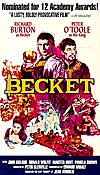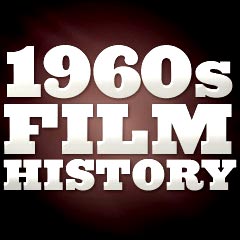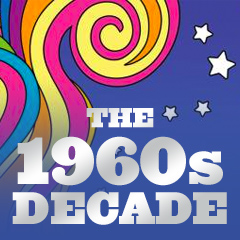|
The New Decade's Major Changes:
Cinema in the 1960s reflected the decade of fun, fashion, rock 'n' roll,
tremendous social changes (i.e., the civil rights era and marches) and
transitional cultural values. This was a turbulent decade of monumental
changes, tragedies, cultural events, assassinations and deaths, and advancements,
such as:
- 1959 - Barbie Doll and the
Microchip invented
- 1960 - Introduction of the
Twist dance by Chubby Checker
- 1962 - Death of Marilyn Monroe
- 1962 - First TV broadcasts
in color
- 1962 - Spacewar, the first
computer video game, invented
- 1962 - The Cuban Missile
Crisis
- 1963 - TouchTone telephones introduced
- 1963 - President John F. Kennedy's assassination
- 1963 - Women's Liberation,
signaled by the publication of Betty Friedan's The Feminine Mystique
- 1964 - Beatlemania, the
Beatles 'invaded' US
- 1964 - Boxer Cassius Clay
joined the Nation of Islam and changed his name to Muhammad Ali
- 1965 - Miniskirt made
first appearance
- 1965 - Watts (LA) race riots
- 1965 - Protests of racial
stereotyping against 'Amos and Andy' TV show forced it off the air
- 1966 - One Million Years BC made Raquel
Welch a sex symbol in a two-piece fur bikini
- 1967 - "Hair"
opened off-Broadway
- 1967 - Human Be-In (Golden Gate Park), and Summer of Love in San Francisco
- 1967 - First Heart Transplant
- 1967 - Anti-Vietnam War Protests Escalated as War Deaths Multiplied
- 1968 - "60 Minutes"
debuted on CBS-TV
- 1968 - Martin Luther King, Jr's and Robert Kennedy's assassinations
- 1969 - Woodstock Musical Festival in upper-state New York
- 1969 - Introduction of
the indoor-safe NERF ball
- 1969 - "Sesame Street" debuted on
TV
- 1969 - Mai Lai
- 1969 - Arpanet (first Internet) invented
- 1969 - The brutal and 'ritualistic' murder
of 26 year-old actress Sharon Tate (Roman Polanski's pregnant wife)
and others in Los Angeles (Bel Air) by Charlie Manson's hippie 'cultic'
family
- 1969 - First Man on the
Moon with Apollo 11 space flight
- 1970 - Kent State Massacre
- 1971 - Charlie Manson and three of his female
followers in their 20s were convicted of the Tate-LaBianca murders,
after the longest murder trial in US history
However, 1963 was the worst year for US film production in fifty years
(there were only 121 feature releases). And the largest number of foreign
films released in the US in any one year was in 1964 (there were 361 foreign
releases in the US vs. 141 US releases).

 With movie audiences declining due to the dominance of television, major
American film companies began to diversify with other forms of entertainment:
records, publishing, TV movies and the production of TV series. For example:
With movie audiences declining due to the dominance of television, major
American film companies began to diversify with other forms of entertainment:
records, publishing, TV movies and the production of TV series. For example:
- in July of 1961, TWA Airlines
began the first regular in-flight movies in first-class during
a NYC to LA flight, with a Bell and Howell projector aimed at a screen
to show the glossy soap opera By Love Possessed (1961), starring
Lana Turner
- in September of 1961, Saturday
Night at the Movies premiered on NBC with the first wide-screen
comedy, How to Marry a Millionaire (1953) - it marked the start
of the trend to broadcast Hollywood movies on TV
- in 1965, Columbia released folk/rock singer Bob Dylan's
album Highway 61 Revisited
- separate awards for Black and White and Color Cinematography
were eliminated by AMPAS for 1967 (and after) films, because most films
were being made in color
Financial Difficulties Within the Film Industry:
Increasingly in the 60s, the major studios financed and distributed independently-produced
domestic pictures. And made-for-TV movies became a regular feature of
network programming by mid-decade. Many "runaway" film productions
were being made abroad to save money. By mid-decade, the average ticket
price was less than a dollar, and the average film budget was slightly
over one and a half million dollars. And by the end of the decade, the
film industry was very troubled and depressed and experiencing an all-time
low that had been developing for almost 25 years.
Studio-bound "contract" stars and directors were no longer. And most
of the directors from the early days of cinema were either retired or
dead. Some of the studios, such as UA and Hal Roach Studios, had to sell
off their backlots as valuable California real estate (for condominiums
and shopping centers). Some sold props (MGM was selling various film artifacts
in 1970, including Dorothy's ruby slippers from The
Wizard of Oz (1939)), offered tours of back lots (Universal began
its famed studio tours in 1964), or created theme parks (DisneyWorld in
Orlando, Florida).
 To
aid the tourist industry and create another attraction, in 1960, the Hollywood
Chamber of Congress inaugurated the Hollywood Walk of Fame (bronzed stars
in pink terrazzo and surrounded by charcoal terrazzo squares that were
embedded in the sidewalks along sections of Hollywood Boulevard and Vine
Street). The first star, placed on February 9, 1960, was for Joanne
Woodward. However, by the mid-70s, Hollywood was better known for its
adult bookstores, prostitutes, and run-down look. To
aid the tourist industry and create another attraction, in 1960, the Hollywood
Chamber of Congress inaugurated the Hollywood Walk of Fame (bronzed stars
in pink terrazzo and surrounded by charcoal terrazzo squares that were
embedded in the sidewalks along sections of Hollywood Boulevard and Vine
Street). The first star, placed on February 9, 1960, was for Joanne
Woodward. However, by the mid-70s, Hollywood was better known for its
adult bookstores, prostitutes, and run-down look.
The Birth of the Multiplex and the Demise of Theatre Palaces:
Stanley H. Durwood became the father of the 'multiplex' movie theater
in 1963 when he opened the first-ever mall multiplex, composed
of two side-by-side theaters with 700 seats at Ward Parkway Center in
Kansas City. Three years later, Durwood introduced the world's first four-plex
and then in 1969, he built a six-plex with automated projection booths.
Durwood went on to head up AMC Entertainment, making it the third-largest
movie theater company in the nation.
Meanwhile, the creation of and flight to the suburbs, the studios' divestiture
of their theatre holdings after 1948, and the impact of television in
the 1950s meant the demise and razing of the benchmark, downtown movie
palaces of the 20s. Architectural wonders, such as the Paramount Theater
in Times Square (New York), projected its last scheduled film in 1964.
The RKO (Hill Street) Theatre in Los Angeles was destined to become a
parking garage soon after. And the RKO Orpheum Theatre in downtown San
Diego, built in 1924, was demolished to make room for a bank.
Studio Take-Overs:
Due to various insecurities and financial difficulties,
the studios were quickly taken over by multi-national companies, especially
after the deaths of pre-war, entrepreneurish movie-studio moguls such
as Louis B. Mayer of MGM and Harry Cohn of Columbia, the ousting of Darryl F. Zanuck from 20th Century Fox in 1971, and the sale of one-third of Warner Bros. stock by Jack Warner to Seven Arts in 1967. The traditional,
Hollywood studio era would soon be history, as more and more studios were
acquired by other unrelated business conglomerates. The age of "packaged"
films and the independent company and producer were beginning.
In the mid- to late 60s, there was a buying/selling frenzy
of the major conglomerates who invested and traded in studios and networks:
- In 1962, the growing entertainment conglomerate MCA
(the Music Corporation of America) acquired Universal-International
Studios (actually Universal-International-Decca), a merger that
would have lasting influence on show business; it developed its strength
as a TV production company
- In 1966, Gulf+Western Industries bought the
floundering Paramount, and made Robert Evans head of the studio's
production; Evans would soon be responsible for some of the studio's
most influential films, such as Rosemary's Baby
(1968), Love Story (1970), The
Godfather (1972), and Chinatown (1974)
which Evans produced
- In 1967, New Line Cinema was founded by Robert
Shaye as a privately-held distributor of art films, such as John Waters'
trash comedy classic Pink Flamingos (1972)
- In 1967, Bank of America absorbed United Artists
through its Transamerica Corporation subsidiary
- In 1967, Jack Warner (co-creator of the famous studio)
sold his controlling interest in Warner Bros. to a Canadian production
and distribution corporation called Seven Arts, and the company
was re-named Warner Bros-Seven Arts. The new company acquired
Atlantic Records, but debt-laden, was sold in 1969 to Kinney National
Services Incorporated, a New York conglomerate whose interests included
parking lots and funeral homes; the studio was later renamed Warner
Communications in 1971
- In 1968, Avco, an aviation equipment and financial
services company, bought Embassy Films from founder Joseph E.
Levine
- In 1969, MGM was acquired by the Las Vegas hotel
financier and airline mogul Kirk Kerkorian, who won control of the studio
in a proxy battle with Seagram's Edgar Bronfman, Sr.; it temporarily
suspended film-making for over ten years, until acquired by United
Artists and relaunched in 1981
- the original, large-screen IMAX projection system
was developed in 1967, and made its debut in 1970 at the Fuji Pavilion
at the World Expo in Osaka, Japan, with a five-story screen and 70mm
film in the projector (and the first IMAX film Tiger Child
- a Multiscreen Corporation production)
The Cleopatra Disaster:
 The much-heralded Joseph L. Mankiewicz film Cleopatra (1963), filmed
on location in Rome, brought together the explosive pairing of Elizabeth
Taylor as the Queen of Egypt and future husband Richard Burton as Marc
Antony, who brought more headlines with their blossoming romance than
the budget problems. It proved to be a tremendous financial disaster for
20th Century Fox, headed by Darryl Zanuck. Taylor, already the highest-paid
performer in the history of Hollywood at $1 million, had a costume wardrobe
budgeted at almost $200,000, and with numerous cost over-runs, extravagant
sets and thousands of costumes for the cast, the film was the most expensive
up to that time at a record $44 million (in adjusted dollars,
about $300 million), from an initial budget of $2 million. It was also the longest, commercially-made
American film released in the US - at 4 hours and 3 minutes. [Fox was
saved from financial disaster only by the release of the fact-based war
epic The Longest Day (1963), an all-star re-creation of the events
surrounding D-Day, and the blow was also softened by the unexpected success
of The Sound of Music (1965).]
The much-heralded Joseph L. Mankiewicz film Cleopatra (1963), filmed
on location in Rome, brought together the explosive pairing of Elizabeth
Taylor as the Queen of Egypt and future husband Richard Burton as Marc
Antony, who brought more headlines with their blossoming romance than
the budget problems. It proved to be a tremendous financial disaster for
20th Century Fox, headed by Darryl Zanuck. Taylor, already the highest-paid
performer in the history of Hollywood at $1 million, had a costume wardrobe
budgeted at almost $200,000, and with numerous cost over-runs, extravagant
sets and thousands of costumes for the cast, the film was the most expensive
up to that time at a record $44 million (in adjusted dollars,
about $300 million), from an initial budget of $2 million. It was also the longest, commercially-made
American film released in the US - at 4 hours and 3 minutes. [Fox was
saved from financial disaster only by the release of the fact-based war
epic The Longest Day (1963), an all-star re-creation of the events
surrounding D-Day, and the blow was also softened by the unexpected success
of The Sound of Music (1965).]
British Influences:
 With
the high cost of producing and making films in Hollywood and the shrinking
of studio size, many studios decreased their internal production and increased
moviemaking outside the country, mostly in Britain (an economically advantageous
production base), making big-budget, big-picture films there. In 1962,
for example, the number of Hollywood films in production had hit an all-time
low, dropping off 26% from the previous year. Two examples of films made
elsewhere included these magnificent historical dramas of 12th century
England: With
the high cost of producing and making films in Hollywood and the shrinking
of studio size, many studios decreased their internal production and increased
moviemaking outside the country, mostly in Britain (an economically advantageous
production base), making big-budget, big-picture films there. In 1962,
for example, the number of Hollywood films in production had hit an all-time
low, dropping off 26% from the previous year. Two examples of films made
elsewhere included these magnificent historical dramas of 12th century
England:
- Becket (1964) with Richard Burton (as Archbishop
Thomas Becket of Canterbury) and Peter O'Toole (as King Henry II), an
Oscar-winning film for Best Screenplay
- The Lion in Winter (1968), the retelling of
the clash between King Henry II (Peter O'Toole reprising his role as
the King) and Eleanor of Aquitaine (Katharine Hepburn), with Oscar wins
for Hepburn and James Goldman's screenplay [this film featured Anthony
Hopkins' feature-film debut as King Richard the Lion-Hearted]
 The
major studios increasingly became financiers and distributors of foreign-made
films. Two of director David Lean's 60's films, the ones that defined
his career's reputation, were made in Britain. The scenic beauty and backdrops
of both films became a tangible character, and opened the door for similar
epic-travelogues: The
major studios increasingly became financiers and distributors of foreign-made
films. Two of director David Lean's 60's films, the ones that defined
his career's reputation, were made in Britain. The scenic beauty and backdrops
of both films became a tangible character, and opened the door for similar
epic-travelogues:
- Lawrence of Arabia (1962) -
the spectacular, adventure epic film made in 70 mm about an enigmatic,
masochistic British officer/hero named Col. T. E. Lawrence who fought
guerrilla-style alongside Omar Sharif (in a breakthrough role), with
Shakespearean actor Peter O'Toole in his first major, Oscar-nominated,
star-making screen role as the homoerotic protagonist; from a revered
screenplay by Robert Bolt
- Doctor Zhivago (1965), a sweeping romantic/historical
drama adapted from Boris Pasternak's Nobel Prize-winning novel of the
days of Russia's Civil War played out against the story of physician
Yuri Zhivago, the two female loves of his life: sensuous mistress Lara
(Julie Christie) and wife Tanya (Geraldine Chaplin), and the villainous
Kamarovsky (Rod Steiger)
The Anglo-American epic A Man For All Seasons (1966)
by director Fred Zinnemann, won six Academy Awards, including Best Picture,
Best Director, and Best Actor Oscars. It portrayed the clash of ideals
between the honorable and principled Sir Thomas More (well-spoken, Oscar-winning
Paul Scofield reprising his stage performance) who sacrificed his own
life as a rebel against the egocentric and tyrannical King Henry VIII
(Robert Shaw).
The Phasing Out of Big Historical Epics:
However, costly historical epics were being phased out.
Two big-money, opulent, epic productions, both directed by Anthony Mann,
were carryovers from the 50s decade of inflated historical epics. These
were made in Spain and Italy respectively, two less expensive movie-making
locations in Europe:
- El Cid (1961) with heroic Charlton Heston as
the legendary 11th century Spanish warrior; Mann made the film after
being fired from the set of Spartacus (1960) - see below
- producer Samuel Bronston's historical drama The
Fall of the Roman Empire (1964) - a disastrous, exorbitant film
that overextended and bankrupted his studio
Nicholas Ray's and Andrew Marton's 70 mm. 55 Days at
Peking (1963), also produced by Samuel Bronston, starred Charlton
Heston and Ava Gardner, and John Huston's religious epic The Bible:
In the Beginning (1966) lost favor as extravagant film productions
of this kind became too costly.
British "Kitchen Sink" Cinema: "Angry
Young Men" Films
A new wave of grim, non-fictional, social realism in British
cinema, dubbed or styled "Kitchen Sink" due to its angry, every-day working-class
heroes, frank dialogue, and negative post-war themes, was exemplified
in the grainy, powerful works of various directors in the late 50s and
early 60s. Most of the directors had backgrounds in theatre, television
and documentaries and brought their talents to the screen.
Their socially-conscious films were also categorized as
"Angry Young Men" films, due to the fact that each one focused
on the economic and social problems of a frustrated male protagonist who
attempted to break free from society and its expectations, through the
use of alcohol, sex, sports, and money, etc. They broke new material by
portraying England's angry and alienated youth in fresh, energetic, and
frank terms:
 Film History of the 1960s
Film History of the 1960s
Part 1, Part 2, Part 3, Part 4, Part 5, Part 6

 
|

